Pelvic organ prolapse: selecting the right repair method
Patients need an individualized approach, says this expert in pelvic reconstructive surgery. Many factors determine whether minimally invasive versus invasive surgery, or abdominal versus vaginal routes of repair are best.
PROLAPSE REPAIR METHODS
Pelvic organ prolapse:
selecting the right repair method
By Robert F. Porges, MD
Patients need an individualized approach, says this expert in pelvic reconstructive surgery. Many factors determine whether minimally invasive versus invasive surgery, or abdominal versus vaginal routes of repair are best.
Which of the many surgical approaches for correcting pelvic organ prolapse (POP) is best for your patient? A woman's age and whether she still wants to have sex are among the patient-centered considerations a gynecologist must weigh in making that judgement.1 You must also take into account surgeon-driven variables, the diagnosis, and other issues that are sometimes unrelated to the gynecologic condition.
Additional patient-driven factors are a woman's medical condition, menopausal status, previous history of pelvic repairs, and her personal biases about the role of the uterus, cervix, ovaries, and type of anesthesia.1 Surgeon-driven factors include the physician's background, range of armamentarium, local availability of surgical, medical, or urologic back-up, stamina, and maybe even a recent negative experience with one method or another. Given these myriad issues, then, it's not surprising to find that patient and surgeon alike don't always clearly understand the reasons for the decision reached. Beyond the POP-specific diagnoses, previous surgical failures, steroid or radiation therapywhich may profoundly influence healingand extraneous diagnoses like coagulopathies, heart disease, and chronic pulmonary disease can all influence your choice of procedure.
Current pressure from patients and insurance payors to provide less invasive surgical treatments is yet another ingredient in the mix.2 The woman wants to have less pain, a shorter hospitalization, a shorter convalescence, and (usually) less time away from work. "Less invasive" is closely linked to "less costly" for the patient, insurance company, and employer, who pays the insurance premium and must cover the woman's absence from her job. The economics of "less invasive," however, are complex. True, a shorter hospitalization saves money, but at the same time sophisticated, disposable instruments are costly, as are the time demands of a difficult laparoscopic operative procedure.
A minimally invasive operation can come at a "high price." Occasionally, visualization of the operative field is unclear and can lead to serious complications that are less common with a more invasive procedure. In addition, newer procedures promoted as minimally invasive are still in their testing stages; therefore, their long-term effectiveness is unknown.
Anatomic background
Pelvic organs are principally supported by intact levator ani muscles, which span the pelvic outlet and attach to the bones and fascia of the skeletal muscles that lie against the pelvic sidewall. Directly above the levator ani muscles is a layer of connective tissues of variable consistency and thickness. These connective tissues invest the pelvic viscera, surround blood vessels, nerves, and ureters, and extend superiorly and circumferentially in the retroperitoneal area.3 Throughout a woman's lifetime, the composition of the endopelvic connective tissues changes, evolving from a relatively thin structure containing mostly elastic tissue to ones that become noticeably thicker and denser from deposition of collagen and loss of elastic fibers in response to mechanical or chemical stress. Anatomic studies of these tissues in cadavers and during repair surgery have differed in their interpretations.
The pelvic organs maintain their normal position over the intact levator ani muscles by the coordinated action of the skeletal muscles and the endopelvic connective tissues, which together produce a physiologic valve (Figure 1) in response to the forces of intra-abdominal pressure and gravity. The muscles function actively, while the connective tissues are more passive. Changes in the density and consistency of the connective tissues do occur over time, especially in response to pregnancy, labor, delivery, chronic constipation, and strenuous physical activity. Genetic factors, lifestyle, obstetrical trauma, and body habitus all determine the evolution of change in the connective tissues. Damage to these tissues may result from abrupt trauma during a delivery, or from chronic, long-standing, subtle injury over a period of many years. While you can assess abrupt injuries following pregnancy with electromyography and magnetic resonance imaging, clinical sequelae may not appear for many years. This extended time lag between injury and symptoms makes it difficult to appreciate the linkage between the injury and its ultimate consequences.
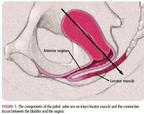
The two types of prolapse
Two forms of pelvic organ support dysfunction are recognized today. In the first, organs protrude beyond the vaginal opening. The second has no recognizable protrusion, although there may be marked descent of the pelvic floor, leading the pelvic viscera to descend below their normal station. MRI imaging of the levator muscles demonstrates a lateral, horizontal segment and a more medial, vertically slanted portion that surrounds and partially encircles the distal rectum and vagina.
Increases in intra-abdominal pressure can cause the skeletal muscles surrounding the abdominal cavity to react in two ways. In the first, as occurs with coughing and sneezing, all of the pelvic floor muscle components contract to their fullest extent to close off any potential openings of the genital hiatus. In the second, with defecation, only the more medial portions of the levator muscle surrounding the distal part of the rectum are permitted to relax.
The disappearance of muscle fibers causes levator ani dysfunction. The fibers disappear either because they're torn away from their insertions laterally, or due to age-related or neurologically caused atrophy. Even when the bulk, tone, voluntary response, and distribution of the levator ani muscle fibers seem intact on physical exam, the muscle actually may fail to contract reflexively in response to increases in intra-abdominal pressure. In general, therefore, dysfunction of the levator muscle results in descent of the pelvic viscera and stretching of the connective tissues. Depending upon the severity of the dysfunction or injury, the endopelvic connective tissues may be stretched or torn (Figures 2 and 3). These defects were described by Cullen Richardson and confirmed by others.4
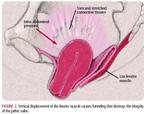
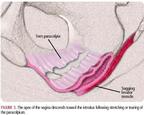
Descent of the pelvic floor, without associated protrusion, may cause no prominent clinical symptoms. Traditionally, surgeons have principally sought to restore prolapsed pelvic structures to their more normal position within the pelvis. The structures susceptible to protrusion include the bladder, urethra, uterus, cul-de-sac, bowel, and rectum. Operations for repositioning all these structures have been in place for more than a century and usually produce a satisfactory outcome for the remainder of a woman's lifetime. However, recurrences requiring re-operation do occur in approximately 10% to 15% of patients.
Most surgeons remove the prolapsed uterus to prevent later development of uterine or cervical cancer, and also to allow inspection of the ovaries, which are often subsequently removed. For most women, surgery for POP occurs at or shortly after the onset of menopause. Today, many women live for 30 to 40 years beyond the time of surgical repair, providing sufficient time for symptomatic POP to recur.
Supracervical hysterectomy, long deemed passé, is more common todayand perhaps justifiablyin regions of the world where adequate cervical cytological surveillance programs exist. There is no evidence, however, that retaining a cervix prevents vaginal prolapse, or improves coital satisfaction.
Reappearance vs. recurrence of pelvic protrusion
While a patient is likely to regard any reappearance of a pelvic protrusion as a recurrence, the term should be carefully defined. For example, a woman who has a vaginal hysterectomy and posterior colporrhaphy for a prolapsed uterus and rectocele and then, later, develops a cystocele, does not really have a recurrence of the original defect. Often women who undergo a sacral colpopexy or sacrospinous ligament fixation (SSLF) for a vault prolapse develop a new cystocele. The reappearance, therefore, of pelvic protrusion may result from redevelopment of a previously addressed defect, or from a defect that was overlooked, or one created to compensate for an adjacent defect. Although all may seem equally catastrophic to a patient, these distinctions will often influence the mode of repair.
Considerations for vault prolapse surgery
Most gynecologists prefer the lithotomy position when operating on patients with pelvic protrusions because the defect that needs repair is thereby closest at hand. Operating through an abdominal incision is usually more awkward when the vaginal wall defect is at the furthest distance from the field, but there are exceptions to the general rule. For example, recurrence of vault prolapse is fairly common after vaginal hysterectomy and vaginal plastic repair. After repairing the associated defect in the distal portions of the anterior and posterior vaginal wall, gynecologists often express concern about replacement of the vaginal vault at a "higher" level than seems possible vaginally. Several procedures are currently in vogue to repair vault prolapse.
Sacrospinous ligament fixation procedure
A surgeon attaching the vaginal vault to the sacrospinous ligament usually approaches vaginally and draws the upper vagina over the levator plate.5 Some have recommended attaching both sides of the vagina, one to each sacrospinous ligament. This step has never been shown to be superior to a unilateral attachment, adds time and risk to the operation, and, in my view, creates a central portion of the vault that may be unprotected and lead to future development of an enterocele (Figure 4).
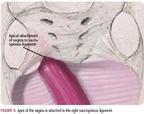
Sometimes, due to a previous operative repair, the vagina is shortened (Figure 5) and cannot be easily attached to the sacrospinous ligament. Drawbacks to attaching the vagina posteriorly are that it may cause tension on the vaginal wall and can also potentially pull the urethra away from the pubic bone, leading to incontinence. In some cases of total eversion, the vagina may become elongated, requiring trimming of the vault before attachment to the sacrospinous ligament.6
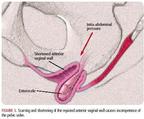
You can take steps to lengthen the vaginal canal, or to attach the vault more anteriorly to the fascia of the iliococcygeus muscle, or pubococcygeus muscle.5,7,8 Vaginal vault attachment is usually done only after enterocele reduction. Further repairs in the lower portions of the posterior compartment are then readily performed without need to reposition and re-drape the patient.
Sacrocolpopexy
The aim of sacrocolpopexy, done either via open laparotomy, or combined with laparoscopy, is likewise to direct the vault posteriorly, corresponding to its normal position within the pelvis. The intervening mesh, between the vaginal vault and sacrum, must be long enough so that its course conforms to the hollow of the sacrum, allowing the vagina to be pressed downward and posteriorly over the levator muscle.
Because vault prolapse is seldom an isolated defect, you may need to re-drape or re-position a patient to complete other aspects of the repair. In our experience, sacrocolpopexy is indicated mainly when there is additional abdominal pathology, if a previous SSLF has failed, or when a narrow subpubic arch or previous narrowing of the vaginal introitus or caliber compromises access to the upper vagina. In cases where a defect in the anterior compartment coexists with a vault prolapse, the choice of repair may hinge on the choice of vault repair. An anterior colporrhaphy will usually precede an SSLF, while a transabdominal paravaginal repair may follow a sacrocolpopexy.
Weight of surgeons' experience
Clearly, operator experience and preference will determine the appropriate method of repair. A senior surgeon should acquire experience in a variety of procedures and allow the details of the individual case to determine the approach. Numerous examples in the literature describe random selection of one versus another approach and conclude with a preference, based on outcome.9-11 Unfortunately, the outcomes are often not measured over a sufficient length of time and may not be comparable to the results of similar approaches by different surgeons.5,7,8,12-14
At times it's expedient and effective to re-attach the prolapsed vaginal vault to the sacrouterine ligament, which normally has a wide, flared-out attachment (or adhesion) to the anterior surface of the sacrum, and may be apparent as a thick band of tissue. A McCall culdoplasty fixes the vaginal apex to the sacrouterine ligament, while producing concomitant narrowing of the cul-de-sac. Cystoscopic surveillance is then required to ensure adequate urinary efflux from both ureteral orifices.
While operator experience weighs heavily in determining the best route of repair, nearly all surgeons select an abdominal sacrocolpopexy for those women who've had a failed SSLF, have a narrow subpubic angle that limits exposure to the deeper areas of the pelvis, who don't need distal portions of the vagina repaired, or have notable abdominal pathology (e.g., an ovarian cyst). A laparoscopic approach for sacrocolpopexy is now somewhat easier thanks to the development of permanent staples for attaching the mesh to the sacral promontory. Recently Petros described "infracoccygeal sacropexy" as a way of fixing the vaginal vault by passing a synthetic mesh through the ischiorectal fossa and rectovaginal fascia, crossing to the other ischiorectal fossa, without fixation of the mesh.15
Cystocele repair
For correcting a cystocele, opinion and practice are divided between an abdominal paravaginal approach and the more conventional vaginal plications. The rationale for the paravaginal approach is based on demonstrated paravaginal tearing of the endopelvic connective tissues close to the pelvic sidewall, resulting in a protrusion of the bladder and the anterior vaginal wall. After dissection at the pelvic sidewall reveals the defect in the endopelvic connective tissues, you can then place sutures at the site of the defect to reattach the endopelvic connective tissues to the arcus tendinous fascia pelvis. The more anterior paravaginal sutures, placed for correction of stress incontinence, have not proved especially effective.
The more consistent results obtained with conventional, overlapping anterior colporrhaphy depend upon suturing of dense layers of connective tissue found between the bladder and vagina. You can use two or sometimes even three rows of interrupted plications, as long as the lateral, dense connective tissues remain available for plication. Should the dense connective tissues under the bladder give way more laterally to fatty areolar connective tissues, the approach must be modified. Either one switches to a paravaginal suturing method, whereby the bladder wall, sidewall of the pelvis, and lateral vaginal wall are all incorporated into a row of interrupted Vicryl sutures, or one attaches a Mersilene mesh underneath the bladder from one sidewall to the other, again from below. This latter method is usually reserved for women who've had several failed surgical procedures.16
The distinction between a central and a lateral defect presumably corresponds to the site of disruption of the endopelvic connective tissues. In practice, though, reduction of the bulge, by whatever means, has practical value because you may never actually determine the difference between a tear, stretching, or "over"stretching. If, at the conclusion of an abdominal hysterectomy, you note a lax, redundant anterior vaginal wall, you can excise a wedge and narrow the vagina.14
Urinary incontinence
For correction of urinary incontinence, the open Burch retropubic urethral suspension is regarded as the gold standard, with restored continence persisting beyond 5 years for more than 90% of patients. Nonabsorbable sutures placed into the vaginal wall on both sides of the urethra and attached above to Cooper's ligament maintain urethral support. More recently, less invasive procedures that use synthetic slings also claim excellent results, although long-term studies are pending. Currently, the emphasis is on degree of invasiveness of the operative procedures, their safety, and long-term effectiveness.
Researchers have most consistently demonstrated the lasting benefit, safety, and low-complication rate of the open Burch retropubic suspension of the paraurethral tissues to the Cooper ligament.17 While this procedure is more invasive than current sling procedures, it has reduced length of hospital stay and postoperative disability rates. Although first described in the early 1900s, suburethral slings using autologous rectus fascia, or fascia lata were not widely used.
Today, synthetic slings may be used in an ambulatory setting, often under local anesthesia with intravenous analgesic supplementation, and patients usually need not stay overnight. Complications include urinary retention, mesh erosion, and occasionally severe complications with major vessel or bowel injury. When recognized, perforation of the bladder during retropubic passage of the trocar is easily repaired and usually does not lead to long-term consequences.
REFERENCES
1. Hullfish KL, Bovbjerg VE, Gibson J, et al. Patient-centered goals for pelvic floor dysfunction surgery: what is success, and is it achieved? Am J Obstet Gynecol. 2002;187:88-92.
2. Dorsey JH, Holtz PM, Griffiths RI, et al. Costs and charges associated with three alternative techniques of hysterectomy. N Engl J Med. 1996;335:476-482.
3. Halban J, Tandler J. Anatomie und Atiology der Genital prolapse beim Weibe. Vienna. Wilhelm Braumuller, 1907; translated by Porges RF, Porges JC. Obstet Gynecol. 1960;15:790-796.
4. Richardson AC, Lyon JB, Williams NL. A new look at pelvic relaxation. Am J Obstet Gynecol. 1976;126:568-573.
5. Porges RF, Smilen SW. Long-term analysis of the surgical management of pelvic support defects. Am J Obstet Gynecol. 1994;171:1518-1528.
6. Kearney R, DeLancey JO. Selecting suspension points and excising the vagina during Michigan four-wall sacrospinous suspension. Obstet Gynecol. 2003;101:325-330.
7. Meeks GR, Wiser WL, McGehee RP, et al. How to repair vaginal vault prolapse by suspension of the vagina to iliococcygeus fascia. J Pelvic Surg. 1996;4:33-38.
8. Shull BL, Capen CV, Riggs MW, et al. Preoperative and postoperative analysis of site-specific pelvic support defects in 81 women treated with sacrospinous ligament suspension and pelvic reconstruction. Am J Obstet Gynecol. 1992;166:1764-1771.
9. Colombo M, Milani R. Sacrospinous ligament fixation and modified McCall culdoplasty during vaginal hysterectomy for advanced uterovaginal prolapse. Am J Obstet Gynecol. 1998;179:13-20.
10. Sze EH, Kohli N, Miklos JR, et al. A retrospective comparison of abdominal sacrocolpopexy with Burch colposuspension versus sacrospinous fixation with transvaginal needle suspension for the management of vaginal vault prolapse and coexisting stress incontinence. Int Urogynecol J Pelvic Floor Dysfunct. 1999;10:390-393.
11. Benson JT, Lucente V, McClellan E. Vaginal versus abdominal reconstructive surgery for the treatment of pelvic support defects: a prospective randomized study with long-term outcome evaluation. Am J Obstet Gynecol. 1996;175:1418-1422.
12. Webb MJ, Aronson MP, Ferguson LK, et al. Posthysterectomy vaginal vault prolapse: primary repair in 693 patients. Obstet Gynecol. 1998;92:281-285.
13. Porges RF. Recurrent pelvic organ prolapse: mechanisms, management, prevention. J Pelvic Surg. 1999;5:267-273.
14. Macer GA. Transabdominal repair of cystocele. West J Surg. 1961;68:182-184.
15. Petros PE. Vault prolapse II: restoration of dynamic vaginal supports by infracoccygeal sacropexy, an axial day-case vaginal procedure. Int Urogynecol J Pelvic Floor Dysfunct. 2001;12:296-303.
16. Julian TM. The efficacy of Marlex mesh in the repair of severe, recurrent vaginal prolapse of the anterior midvaginal wall. Am J Obstet Gynecol. 1996;175:1472-1475.
17. Kenton K, Oldham L, Brubaker L. Open Burch urethropexy has a low rate of perioperative complications. Am J Obstet Gynecol. 2002;187:107-110.
SUGGESTED READING
DeLancey JO. Anatomic aspects of vaginal eversion after hysterectomy. Am J Obstet Gynecol. 1992;166:1717-1724.
Morley GW, DeLancey JO. Sacrospinous ligament fixation for eversion of the vagina. Am J Obstet Gynecol. 1988;158: 872-881.
Nguyen JK. Current concepts in the diagnosis and surgical repair of anterior vaginal prolapse due to paravaginal defects. Obstet Gynecol Surv. 2001;56: 239-246.
Snyder TE, Krantz KE. Abdominal-retroperitoneal sacral colpopexy for the correction of vaginal prolapse. Obstet Gynecol. 1991;77:944-949.
Timmons MC, Addison WA, Addison SB, et al. Abdominal sacral colpopexy in 163 women with posthysterectomy vaginal vault prolapse and enterocele Evolution of operative techniques. J Reprod Med. 1992;37:323-327.
Dr. Porges is Professor and Vice-Chairman, Department of Obstetrics/Gynecology, New York University School of Medicine, New York, N.Y.
Key points
- Either abrupt trauma during a delivery or chronic, long-standing, subtle injury over a period of many years can damage endopelvic connective tissues and skeletal muscles that help to maintain the pelvic organs in their normal position.
- The two forms of pelvic organ support dysfunction are: the type characterized by organs protruding beyond the vaginal opening and the kind with no recognizable protrusion but possibly marked descent of the pelvic floor.
- Although results of operations to re-position the bladder, urethra, uterus, cul-de-sac, bowel, or rectum (structures susceptible to protruding into the vagina when muscles and tissue weaken) usually last a lifetime, recurrences requiring re-operation occur about 10% to 15% of the time.
- Sacrocolpopexy is indicated mainly when there is additional abdominal pathology, if a previous SSLF has failed, or when a narrow subpubic arch or previous narrowing of the vaginal introitus or caliber compromises access to the upper vagina.
Robert Porges. Pelvic organ prolapse: selecting the right repair method.
Contemporary Ob/Gyn
Jul. 1, 2003;48:28-40.
